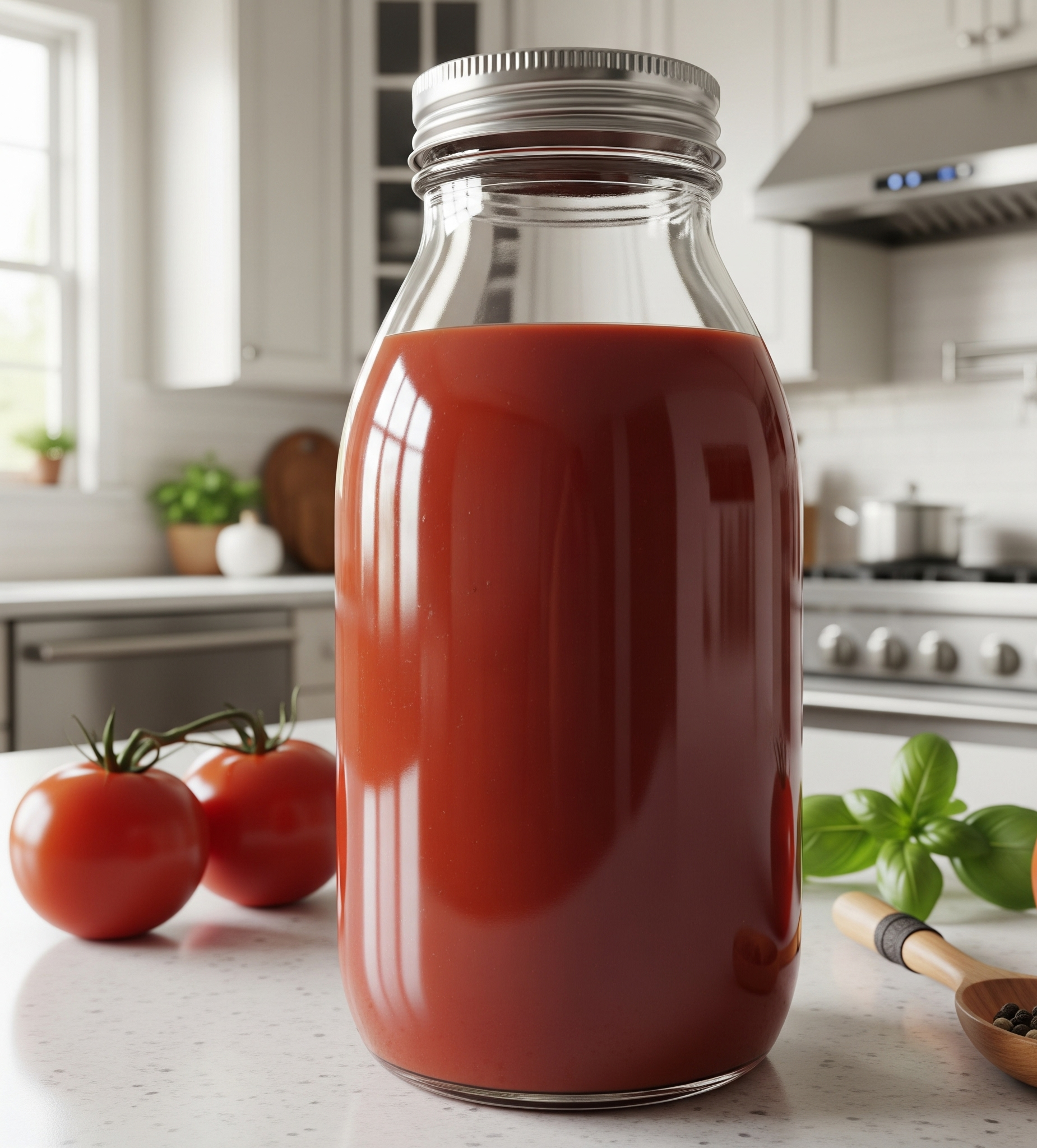Learn how to make fresh and delicious homemade tomato ketchup with simple ingredients. Perfect for snacks, fries & burgers. Step-by-step guide with pro tips.
Tomato Ketchup Recipe is a classic condiment made from a smooth, thick sauce of cooked tomatoes, vinegar, sugar, salt, and various spices. Its distinctively sweet and tangy flavor makes it a popular pairing for a wide variety of foods, from french fries and hamburgers to eggs and fried snacks.
Prep Time: 15 minutes | Cook Time: 60 minutes | Total Time: 1 hour 15 minutes Servings: 2 cups
Ingredients for Tomato Ketchup Recipe
- 2 kg (about 4.5 lbs) fresh, ripe red tomatoes
- 1 large onion, chopped
- 4 cloves garlic, peeled
- ½ cup white vinegar
- ½ cup brown sugar (or to taste)
- 1 teaspoon salt (or to taste)
- 1 tablespoon paprika
- ½ teaspoon cayenne pepper (optional, for a spicy kick)
- ½ teaspoon ground mustard
- ¼ teaspoon ground cloves
- ¼ teaspoon ground allspice
Instructions for Tomato Ketchup Recipe
Step 1: Prepare and Cook the Tomatoes
Wash and roughly chop the fresh tomatoes. In a large saucepan, combine the chopped tomatoes, onion, and garlic. Bring the mixture to a boil over medium-high heat, then reduce the heat to a simmer. Cook for 25-30 minutes, or until the tomatoes are very soft and the mixture has reduced.
Step 2: Blend and Strain the Mixture
Allow the tomato mixture to cool slightly. Carefully transfer the contents to a blender and blend until a smooth puree is formed. To get that silky-smooth ketchup texture, press the puree through a fine-mesh sieve into a clean bowl, discarding the seeds and skins.
Step 3: Thicken the Ketchup
Pour the strained tomato puree back into the saucepan. Add the vinegar, brown sugar, salt, paprika, cayenne pepper (if using), ground mustard, cloves, and allspice. Stir well to combine all ingredients.
Step 4: Simmer to Perfection
Bring the mixture to a gentle simmer over low to medium heat. Cook uncovered for 30-40 minutes, stirring frequently to prevent sticking. The ketchup is ready when it has thickened to your desired consistency and can coat the back of a spoon without dripping off.
Step 5: Cool and Store
Turn off the heat and let the homemade ketchup cool completely. Pour it into a sterilized airtight glass jar or bottle. Store in the refrigerator for up to one month.
Based on my analysis of top-ranking recipe sites and SEO best practices, here is a step-by-step tomato ketchup recipe optimized for search engines. This guide uses clear, concise instructions, incorporates relevant keywords naturally, and is structured for both user experience and search engine visibility.
Expert Tips & Variations
- For a smoother texture: If your ketchup isn’t as smooth as you’d like, consider running the final mixture through the sieve one more time after cooking.
- Adjusting the flavor: Taste the ketchup after it has thickened and cooled. You can add more sugar for sweetness, vinegar for tanginess, or salt and spices to your preference.
- Longer shelf life: Ensure your jar is properly sterilized. The vinegar and salt in this recipe act as natural preservatives, but for a longer-lasting ketchup (up to 3 months), you can increase the amount of vinegar slightly.
- Alternative sweeteners: For a refined sugar-free option, you can use honey or maple syrup. Be sure to add these to taste, as their sweetness levels differ from sugar.
FAQs for Homemade Tomato Ketchup
How long does homemade ketchup last?
When stored in a sterilized jar in the refrigerator, homemade tomato ketchup can last for up to one month. The vinegar and salt act as natural preservatives.
Why is my ketchup watery and not thickening?
The most common reason is not cooking it for long enough. To thicken your ketchup, return it to the stove and simmer it uncovered for another 10-15 minutes, stirring frequently, until it reaches your desired consistency.
Can I adjust the spices in the recipe?
Absolutely. The spices in this recipe can be customized to your taste. For a spicier ketchup, add more cayenne pepper. For a different flavor profile, you can experiment with spices like coriander powder or celery salt.
How do I sterilize my storage jar?
You can sterilize a glass jar by washing it thoroughly, placing it in a pot of boiling water for 10 minutes, and then letting it air dry completely on a clean rack. Alternatively, you can run it through a hot cycle in your dishwasher.
Is tomato ketchup good for health?
While ketchup, especially homemade or organic versions, can offer some health benefits due to its tomato content, commercially produced ketchup is often high in sugar, salt, and preservatives, which can be detrimental to health if consumed in large quantities. It’s best to consume ketchup in moderation and opt for healthier, lower-sugar, and lower-sodium alternatives when possible.
Is ketchup a junk food?
It’s higher in sugar than mustard, which is pretty much sugar-free, and has a similar sugar content to brown sauce. Nutritionally, ketchup sits somewhere in the middle. It’s hardly a health food, but it’s not the worst condiment on the table either.
Is tomato ketchup full of sugar?
Often seen as the ‘nation’s favourite sauce’, tomato ketchup contains around 27.5g of sugar per 100g. You may be thinking “100g, you’d have to eat a lot of ketchup”! But to put this into everyday terms, 1 tablespoon of ketchup contains about 1 teaspoon of sugar.
Is ketchup good for diabetics?
While people with diabetes can eat ketchup, it should be consumed in moderation due to its sugar content. One tablespoon of ketchup typically contains around 4 grams of added sugar. Choosing no-sugar-added or reduced-sugar versions can be a good alternative for those who love ketchup.
What is unhealthy in ketchup?
Two ingredients of concern in ketchup are salt and sugar. Per tablespoon, ketchup contains 4 grams of sugar and 190 milligrams of sodium. Although 4 grams of sugar doesn’t seem like a lot, much of it comes from added sugar, as opposed to the natural sugar found in tomatoes.
Which is healthier, tomato sauce or ketchup?
Generally, tomato sauce is considered healthier than ketchup. While both are made from tomatoes, tomato sauce typically has lower sugar and sodium content, and offers more dietary fiber and iron. Ketchup, on the other hand, often contains added sugar and sodium to enhance flavor and preservation.
Is ketchup healthier than mayonnaise?
Not only is it lower in calories, but ketchup’s tomato base means it is crammed with metabolism-maxing micronutrients like copper, phosphorus, iron and Vitamin B6.
Which ketchup is better?
The Best Store-Bought Ketchup, Ranked
Tomato Ketchup Arti’s Recipes
Burman’s Tomato Ketchup.
Annie’s Organic Ketchup.
Hunts 100% Natural Tomato Ketchup.
Del Monte Tomato Ketchup.
Great Value Tomato Ketchup.
Rao’s Roma Tomato Ketchup.
Heinz Tomato Ketchup.
Market Pantry Tomato Ketchup.
What happens when you eat a lot of ketchup?
Let’s see the top side effects of ketchup: 👉🏻 Acid reflux Tomatoes are also rich in citric and malic acid. When too much of these substances accumulate in your stomach, it will cause heartburn or acid reflux. 👉🏻 Allergic reactions Consuming food that is rich in this compound leads to the development of rashes.
Which is the best ketchup in India?
Home made ketchup by Arti’s Recipes.
Is tomato sauce good for health?
Yes, tomato sauce can be a healthy addition to your diet, primarily due to the nutritional benefits of tomatoes. Tomatoes are rich in antioxidants like lycopene, which has been linked to reduced risks of heart disease and certain cancers. Additionally, tomato sauce contains vitamins A and C, as well as potassium, which can contribute to overall health.
What’s the difference between tomato jam and tomato chutney?
Texture: Jam is smooth or slightly chunky, made to spread easily on toast. Chutney is chunkier, with bits of fruit, vegetables, and sometimes nuts or raisins adding texture. Flavor Profile: Jams are fruit-forward and primarily sweet, whereas chutneys have a bold mix of tangy, spiced, and sometimes smoky flavors.
What’s the difference between tomato ketchup and Green chutney?
Tomato ketchup and Green Chutney are both popular condiments, but they differ significantly in their ingredients, flavor profile, texture, and typical culinary uses.
Here’s a breakdown of the key differences:
Tomato Ketchup:
Main Ingredients: Primarily made from cooked tomatoes, sugar, vinegar, salt, and a blend of spices (like onion powder, garlic powder, allspice, cloves, and paprika).
Flavor Profile: Characteristically sweet and tangy, with an umami depth from the cooked tomatoes. It generally has a milder spice level.
Texture: Typically very smooth and thick. Commercial ketchups often contain thickeners (like xanthan gum) for a consistent pour.
Color: Deep red.
Culinary Use: A universal condiment, most commonly associated with Western fast food. It’s used as a dipping sauce for french fries, hamburgers, hot dogs, chicken nuggets, and eggs. It can also be a base for other sauces (like BBQ sauce) or used in cooking.
Serving Temperature: Almost always served cold.
Green Chutney (Hari Chutney):
Main Ingredients: Primarily made from fresh green herbs, most commonly coriander (cilantro) and/or mint leaves. Other ingredients typically include green chilies, ginger, garlic, lemon juice or tamarind for tang, and various Indian spices like cumin, black salt, and chaat masala.
Flavor Profile: Spicy, fresh, tangy, and aromatic. The exact flavor can vary greatly depending on the herbs and spices used, ranging from mildly piquant to intensely fiery.
Texture: Can range from a coarse paste to a smoother puree, depending on the grinding method and desired consistency. It’s generally less uniform than ketchup.
Color: Vibrant green.
Culinary Use: A staple in Indian and South Asian cuisine. It’s a versatile accompaniment to a wide range of dishes, including:
Dipping Sauce: For samosas, pakoras, kebabs, and various fried snacks.
Chaat: Essential for popular Indian street foods like pani puri, bhel puri, and sev puri.
Spreads: Used in sandwiches and wraps.
Accompaniment: Served alongside main meals like curries and biryanis.
Serving Temperature: Typically served fresh and cold, though sometimes incorporated into warm dishes.
In summary:
While both are condiments, tomato ketchup is a globally recognized, sweet-tangy, smooth, and typically red sauce, popular with fried foods, whereas green chutney is a distinctly Indian/South Asian, fresh, spicy, tangy, and green herbal paste used to enhance a variety of traditional dishes and snacks.
What’s the difference between tomato ketchup and Khajoor imli chutney?
Tomato ketchup and Khajoor Imli Chutney are two distinct condiments, each with a unique flavor profile and culinary background.
Tomato Ketchup is a universally recognized condiment originating from Western cuisine. Its main ingredients are cooked tomatoes, vinegar, sugar, salt, and a blend of spices like onion powder and garlic powder. This combination gives it a predominantly sweet and tangy flavor, with a savory undertone from the tomatoes. The texture is typically very smooth and thick. Ketchup is most famous as a dipping sauce for fast food items such as french fries, hamburgers, and chicken nuggets.
Khajoor Imli Chutney is a traditional Indian condiment. Its primary ingredients are dates (khajur), tamarind (imli), and jaggery (gur), along with a mix of Indian spices like cumin, red chili powder, and black salt. This combination results in a complex flavor profile that is a perfect balance of sweet from the dates and jaggery, and sour from the tamarind. The spices add a warm, savory, and sometimes spicy kick. The texture is a thick paste that can be either smooth or slightly chunky. Khajoor Imli Chutney is a staple in Indian cuisine, particularly for street food like samosas, pani puri, and chaat, where its unique flavor is essential.



Looks so yummy! can’t wait to try this💗🍅🍅🍅
Really nice this!!!